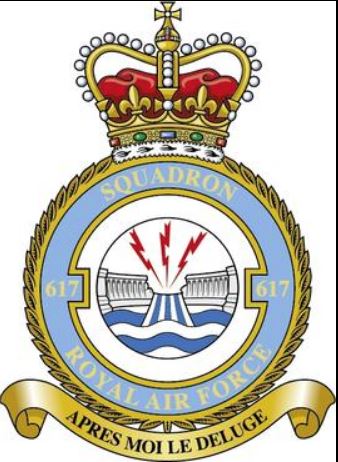No. 617 Squadron RAF
From Our Contribution
 Squadron badge | |
Contents
Brief History
The squadron was formed RAF Scampton on 21 March 1943. It included personnel from Canada, Australian, and New Zealand in addition to UK. It was formed for the specific task of attacking three major dams that contributed water and power to the Ruhr industrial region in Germany: the Möhne, Eder and Sorpe. The squadron had to develop the tactics to deploy Barnes Wallis's "Bouncing bomb".
Throughout the rest of the war, the squadron continued in a specialist and precision-bombing role, including the use of the enormous "Tallboy" and "Grand Slam" ground-penetrating earthquake bombs, on targets such as concrete U-boat shelters and bridges. Several failed attempts were made on The Dortmund-Ems Canal in 1943 before it was finally breached with Tallboys in September 1944. In March 1945 the squadron used the Grand Slam bomb for the first time, against the Bielefeld viaduct, wrecking it. The viaduct had withstood 54 previous attacks without being permanently neutralized.
The Squadron participated in a series of attacks on the Tirpitz, a major German battleship that had been moved into a fjord in northern Norway from where she threatened the Arctic convoys. Too far north to be attacked by air from the UK, she had been damaged by an attack by midget submarines and a series of attacks from carrier-borne aircraft. However, both attacks had failed to sink her. No. 617 and No. IX Squadrons were then deployed to a Russian airfield within range of Tirpitz. On 15 Sep 1944, the RAF bombers struck the battleship in the forecastle with a "Tallboy" bomb, which rendered her unseaworthy, but did not sink her. Sent to the Tromsø fjord for temporary repairs, she was anchored as a floating battery. However, this fjord was now in range of bombers operating from Scotland and from there, in October, she was attacked again. Finally on 12 Nov 1944, the two squadrons again attacked Tirpitz, and although the first bombs missed their target, following aircraft scored two direct hits in quick succession. Within ten minutes of the first bomb hitting the Tirpitz, she suffered a magazine explosion and capsized killing 1,000 of her 1,700 crew.
During the Second World War the Squadron carried out 1,599 operational sorties with the loss of 32 aircraft
Squadron Personnel
- Phillip Herbert Martin DFC & Bar 1 Sep 1944 - 20 May 1945
Battle Honours
Individual Honours
Notes